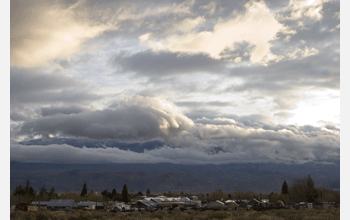Multimedia Gallery
T-REX Experiment (Image 1)
The town of Independence, Calif., at sunrise during the Terrain-induced Rotor Experiment (T-REX) field project. The purpose of T-REX was to study a severe type of atmospheric turbulence--called rotors--that forms near mountains in the California Sierra Nevada range, posing a threat to planes flying in the vicinity. Rotors, which form on the lee side of high, steep mountains, have contributed to a number of aircraft accidents, but scientists know little about their structure and evolution. They are common in the Sierras because the area has the steepest topography in the continental United States.
Research was conducted both on the ground, where researchers probed rotors with radars, lidars (laser-based radars), automated weather stations, wind profilers and balloons, and in the air using HIAPER (for High-Performance Instrumented Airborne Platform for Environmental Research), a modified Gulfstream V jet. Owned by the National Science Foundation (NSF) and operated by the National Center for Atmospheric Research (NCAR) in Boulder, Colo., HIAPER is capable of reaching an altitude of 51,000 feet and cruising for 7,000 miles, making it ideally suited for the T-Rex experiment, according to atmospheric researchers.
The project included scientists from NCAR, the Desert Research Institute and other institutions, and was supported by NSF. To learn more about the T-REX project, see the NSF Discovery story, "New NSF Aircraft to Probe Hazardous Atmospheric Whirlwinds."
NCAR is supported by NSF and other federal agencies to provide facilities and support for a wide range of studies in the atmospheric and related sciences. NCAR is managed by the University Corporation for Atmospheric Research (UCAR), a nonprofit consortium of universities that grants Ph.D.s in fields related to atmospheric science. UCAR's primary function is managing NCAR. To learn more, visit the NCAR website, Here. [Image 1 of 3 related images. See Image 2.]
Credit: ©University Corporation for Atmospheric Research
Special Restrictions: This image is owned by UCAR. Before using this image, please read the UCAR Conditions for Use.
Images and other media in the National Science Foundation Multimedia Gallery are available for use in print and electronic material by NSF employees, members of the media, university staff, teachers and the general public. All media in the gallery are intended for personal, educational and nonprofit/non-commercial use only.
Images credited to the National Science Foundation, a federal agency, are in the public domain. The images were created by employees of the United States Government as part of their official duties or prepared by contractors as "works for hire" for NSF. You may freely use NSF-credited images and, at your discretion, credit NSF with a "Courtesy: National Science Foundation" notation.
Additional information about general usage can be found in Conditions.
Also Available:
Download the high-resolution TIF version of the image. (24.5 MB)
Use your mouse to right-click (Mac users may need to Ctrl-click) the link above and choose the option that will save the file or target to your computer.



